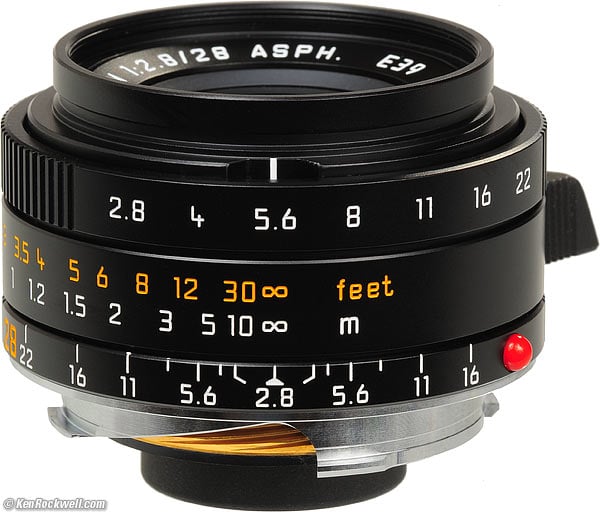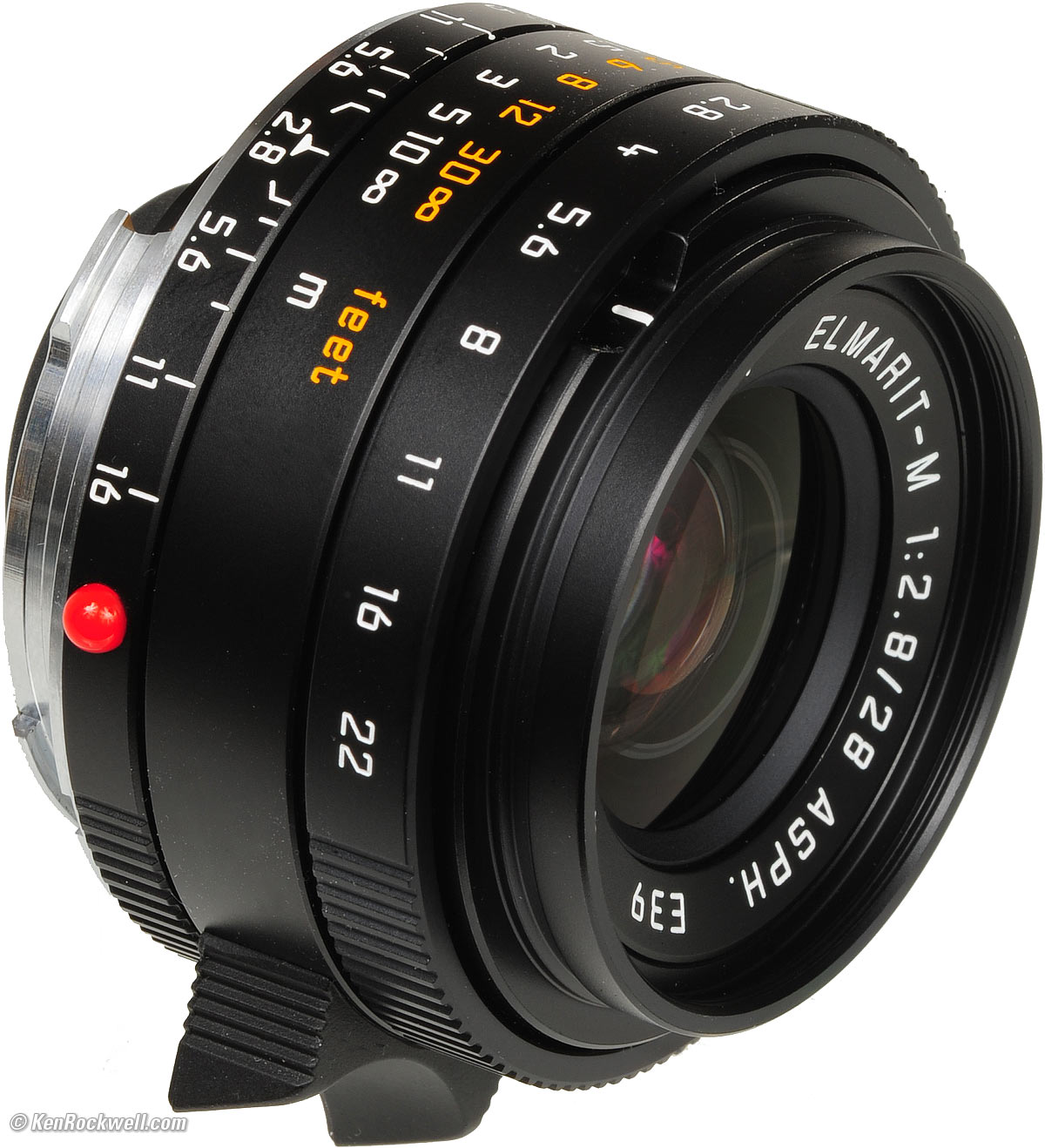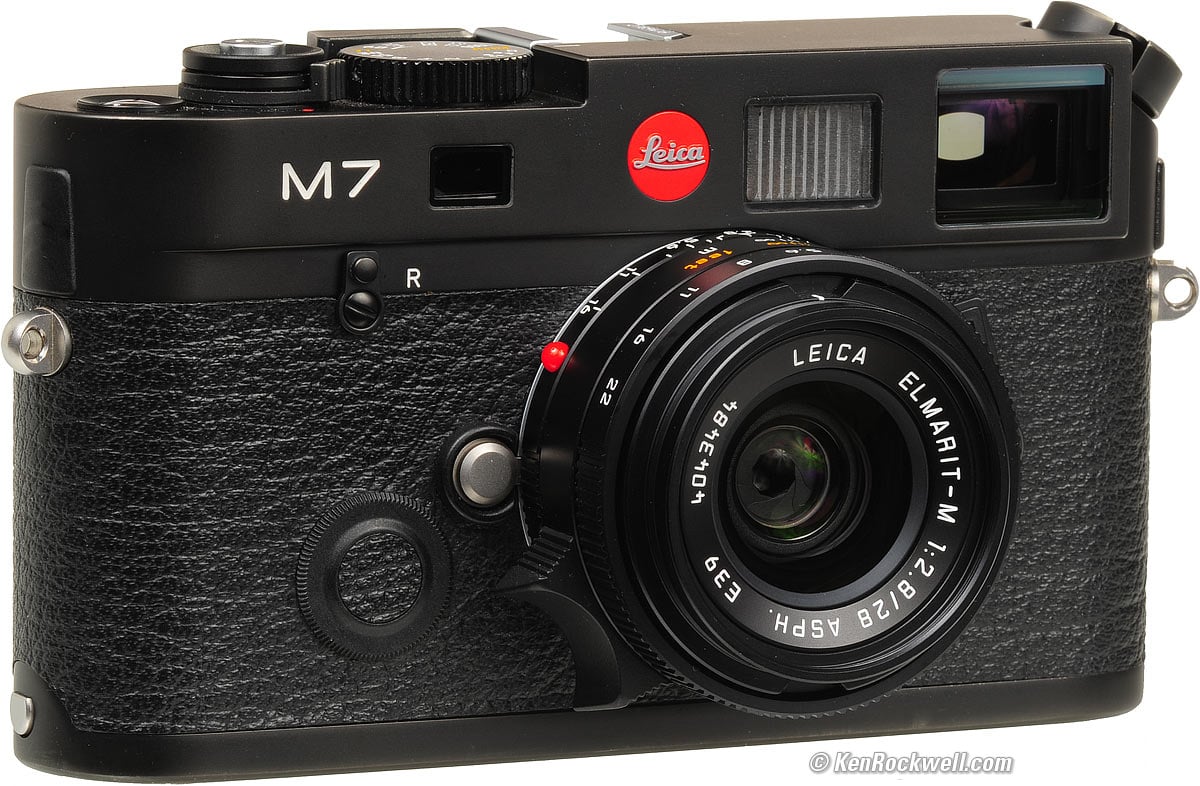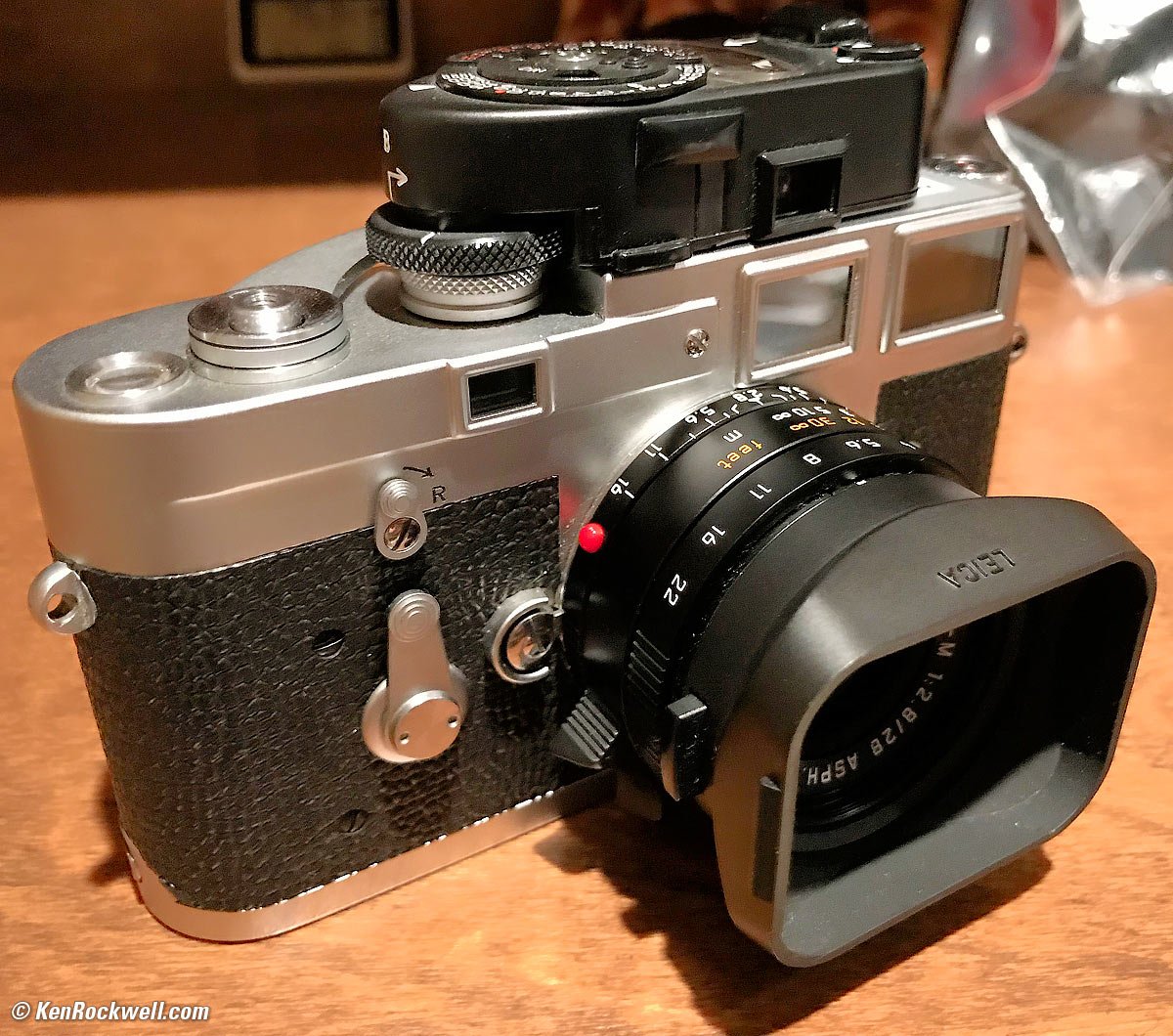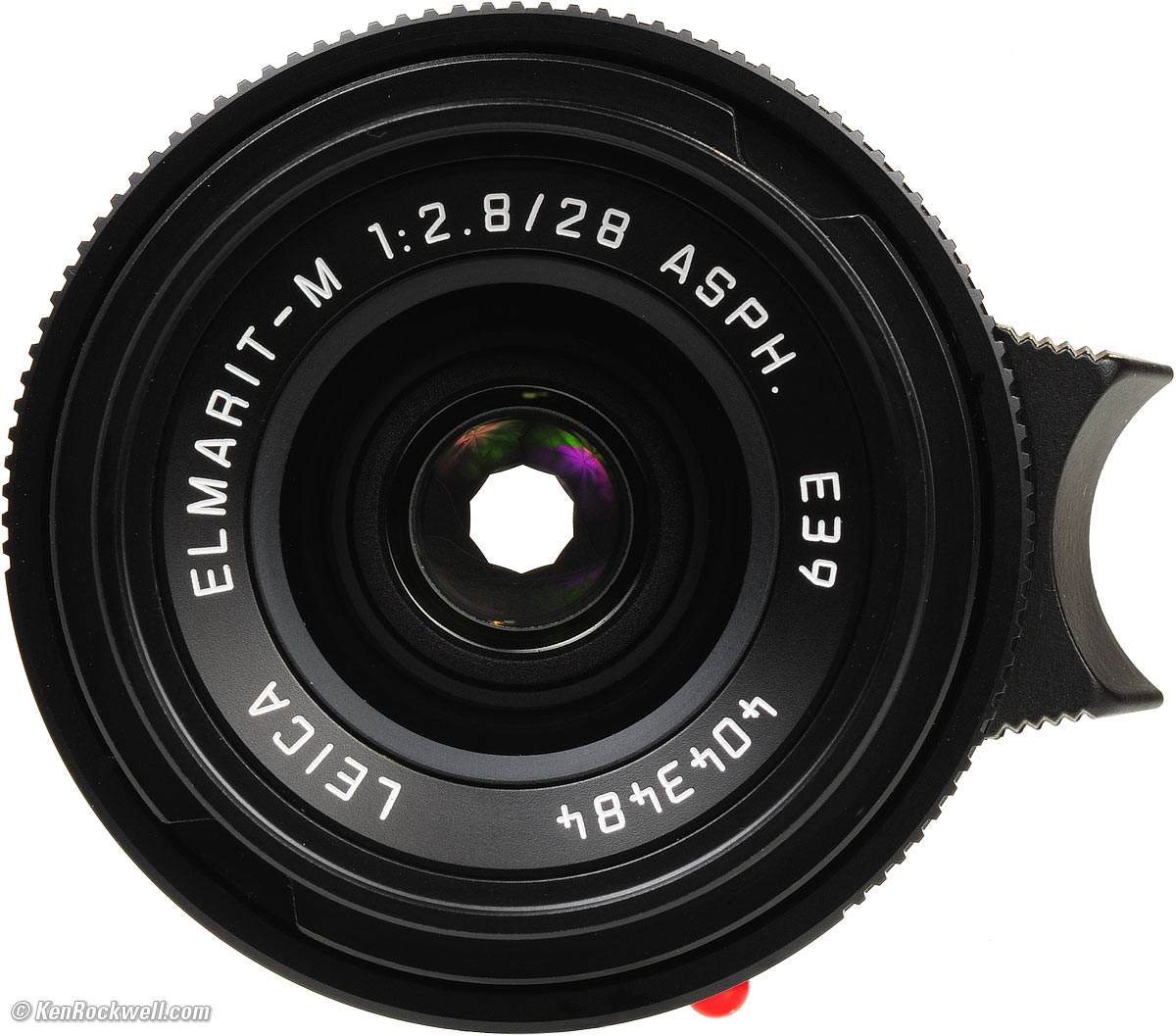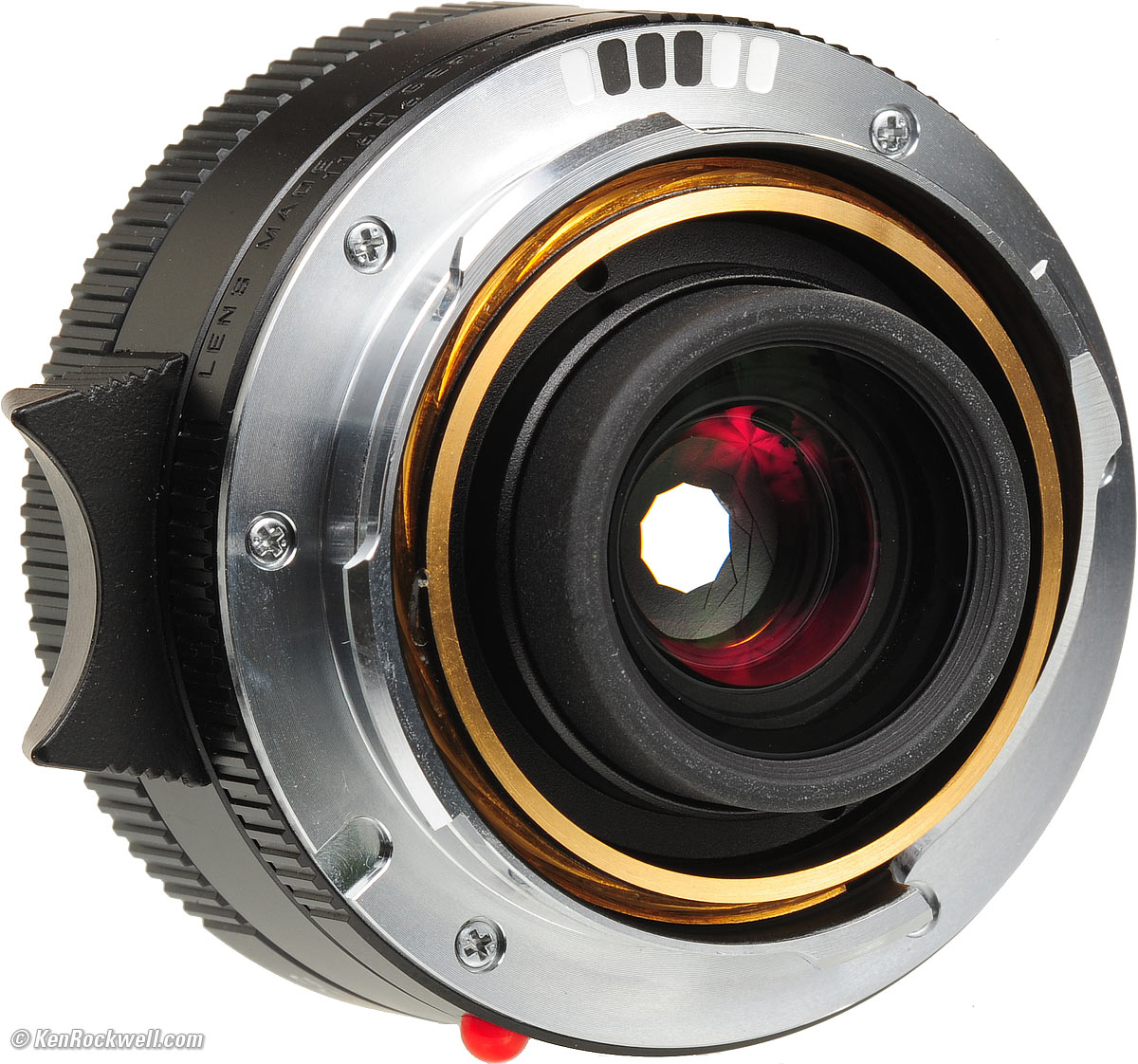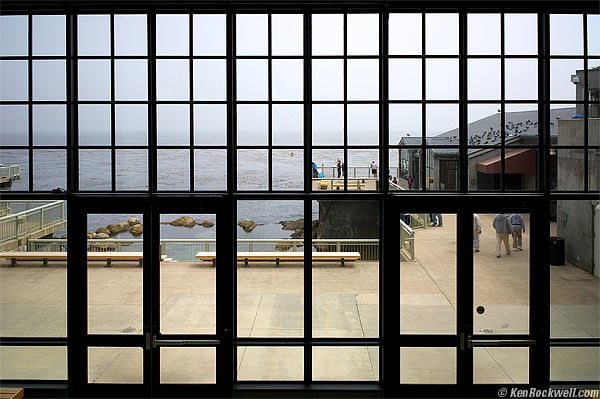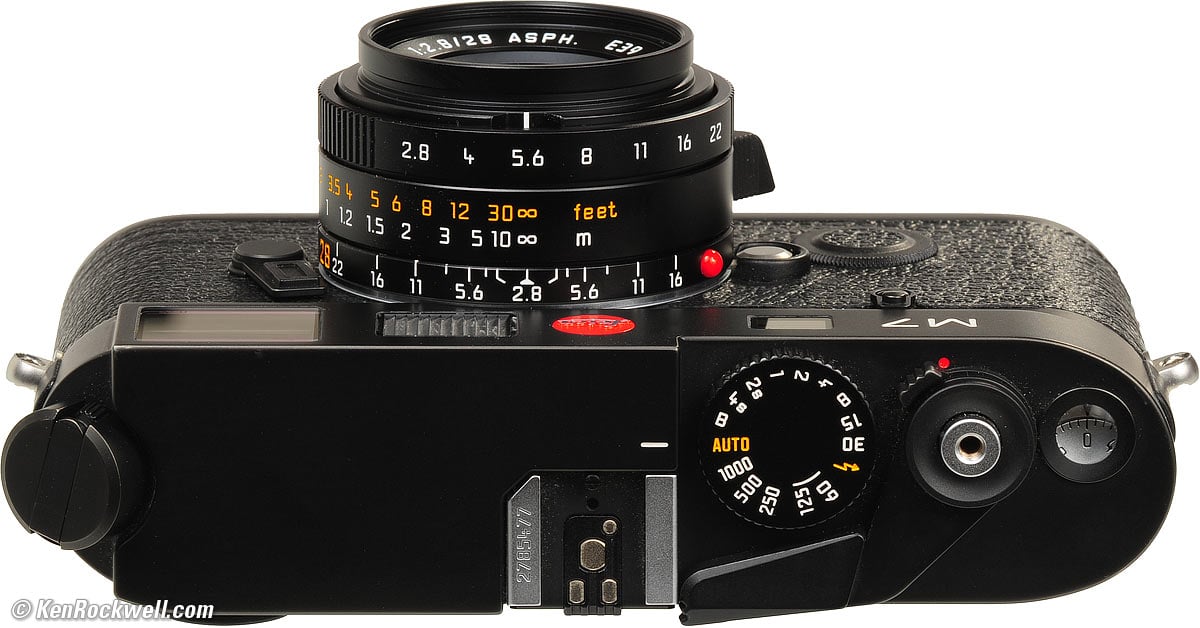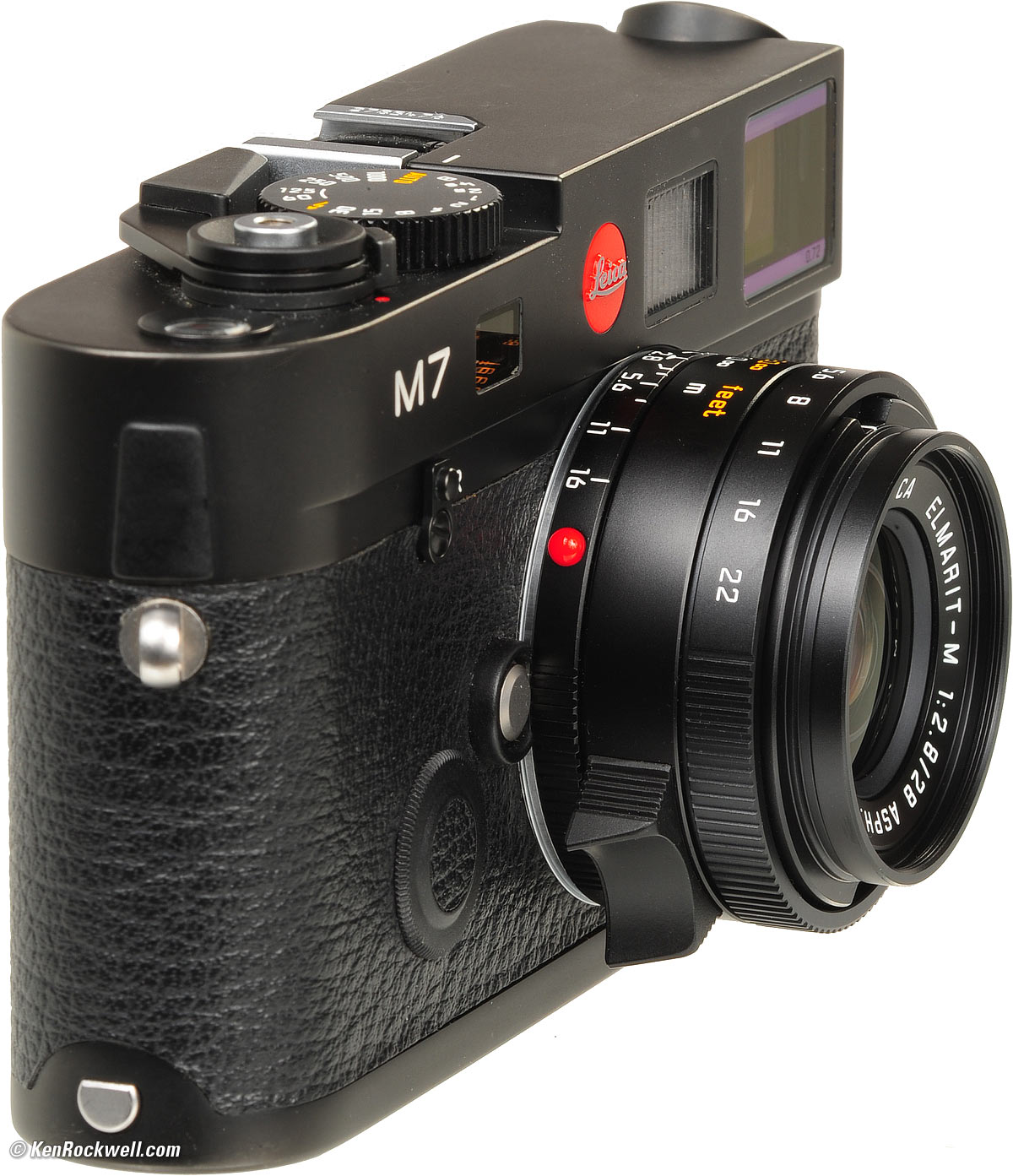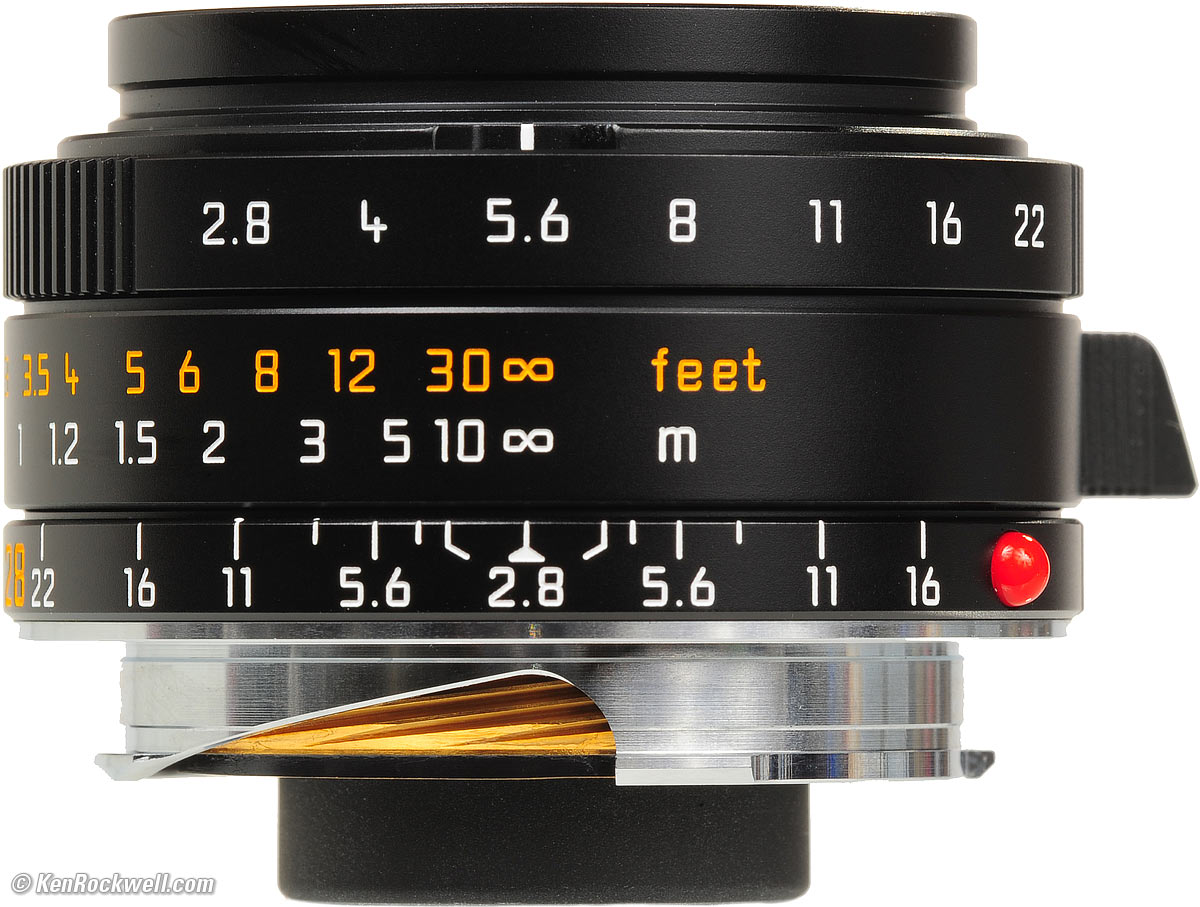Home Donate New Search Gallery Reviews How-To Books Links Workshops About Contact
LEICA 28mm f/2.8 ASPH
ELMARIT-M (2006-today)
Intro Specs Performance Recommendations More
LEICA ELMARIT-M 1:2,8 28mm f/2.8 ASPH (39mm filters, 6.107 oz./173.18g, about $2,297). bigger. This is the original typ 11606 version with plastic hood; today I'd get the new typ 11677 version with metal hood at Adorama, at B&H or at Amazon.
You can get the old version shown here with the plastic hood at Amazon or used at eBay for about $1,500 if you know How to Win at eBay). Both versions have the same optics, they only vary in the kind of hood.
This all-content, junk-free website's biggest source of support is when you use those or any of these links to approved sources when you get anything, regardless of the country in which you live. Buy only from the approved sources I use myself for the best prices, service, return policies and selection. Thanks for helping me help you! Ken.
October 2017
LEICA Camera Reviews LEICA Lens Reviews Recommended LEICA Lenses
How to Use Wide Lenses How to Afford Anything LEICA Lens Names
Sample Images
Yosemite in Springtime May 2011
Death Valley January 2009
| Optics: | |
| Mechanics: | |
| Ergonomics: | |
| Usefulness: | |
| Availability: | |
| Overall: |
Introduction top
The LEICA 28mm f/2.8 ASPH is LEICA's newest 28mm lens for its timeless M series of rangefinder cameras. It started shipping in October 2006.
It works on every film and digital LEICA M made, from the film LEICA M3 of 1954 through today's M7 and digital LEICA M9-P, M240 and M10.
The reasons I bought this lens new are simple:
1.) It's the smallest M lens LEICA has ever made. It's their first 28mm which doesn't get in the way of the viewfinder. It uses standard 39mm filters, which are the same size as LEICA's other compact lenses. Other 28mm lenses are bigger, and therefore block the lower right portion of your viewfinder!
2.) Zero distortion and ridiculous sharpness. It's got less distortion than the bigger 28mm f/2 ASPH, which would block the viewfinder.
Whiners always moan that "they don't make them like they used to," but this LEICA lens looks and feels at least as well made as every other LEICA lens I've used, made since 1954. It's certainly nicer than the budget Summarit-M series.
The typ 11606 version shown here was made from 2006~2016. The newer typ 11677 version has been made from January 2016~, it uses the same optics and is the same size and weight and differs only in that it takes a metal hood instead of the plastic one of this lens.
LEICA 28/2.8 ELMARIT-M, many times larger than life. enlarge more.
The LEICA 28mm f/2.8 on a LEICA M7. enlarge.
LEICA 28mm f/2.8 ASPH on LEICA M3 mit LEICAMETER MR-4. bigger.
Specifications top
Intro Specs Performance Recommendations
LEICA 28mm/2.8 ASPH set to f/5.6. enlarge.
|
I buy only from these approved sources. I can't vouch for ads below. |
Name
LEICA calls this the LEICA ELMARIT-M 1:2,8/28 ASPH.
-M was added to ELMARITs for LEICA M in the 1970s to differentiate them from the LEICA R SLR lenses.
Optics
8 elements in 6 groups.
One aspheric surface.
Actual (Design) Focal Length
28.5mm.
(Used on the half-frame M8, its angle of view corresponds only to what a 38mm lens would see on a real LEICA.)
Diaphragm
10 blades.
Straight at f/4, becoming inwardly-curved from f/5.6 ~ f/11, and straight again from f/16 ~ f/22.
Uniform half-stop clicks.
Stops down to f/22.
Filter Thread
E39: 39mm x 0.5mm thread pitch.
This has been the standard pitch for 39mm since at least the 1950s, and it matches LEICA's other 39mm thread lenses and standard Hoya filters I've tried since 1954.
The Germans say "E39," which just means screw-in 39mm.
Close Focus
2.3 feet (28" or 0.7 meters).
Maximum Reproduction Ratio
1:22.
Hood
Clip-on rectangular plastic, included.
Hood Part Number: 12 526.
Designed for full-frame use; not the half-frame M8.
Size: 42mm slip-over (A42 in German).
The front snap-on mount matches my 50mm f/2 from 1970 and the 90mm f/2.8 Tele-ELMARIT-M from 1974-1990.
The hood's design is flawed: there is no vent through which the camera's viewfinder can see. Use the hood, and you'll see it as a black spot covering the lower right of your camera's finder.
Half-frame shooters probably won't see this with the M8, since the M8 throws away half the lens' image.
Rear, LEICA ELMARIT-M 28mm 1:2.8 ASPH at f/5.6. enlarge.
Lens Caps
Comes with three caps:
Standard M rear cap 14 269.
Slip-on metal front cap 14 038 (for use without hood).
Floppy (easy to lose) rectangular plastic cover for the hood (cap part number 14 043).
Older M rear caps from normal and tele lenses won't work because they're not deep enough. Use the current 14269 cap, which is deep enough.
Case
Comes with a very nice genuine nappa leather case, order number 439-606.052-000.
This leather case is used only when placing the ELMARIT-M ASPH in your safe; not when you're out shooting with it.
Size
2.05" diameter x 1.18" long (52 x 30mm), without hood.
Hood makes the length 1.81" (46mm).
Weight
6.107 oz. (173.18g) measured without caps or hood.
6.970 oz (197.55g) measured with hood and both relevant caps.
LEICA specifies "approximately 6.35 oz. (180g)."
6-Bit Encoding
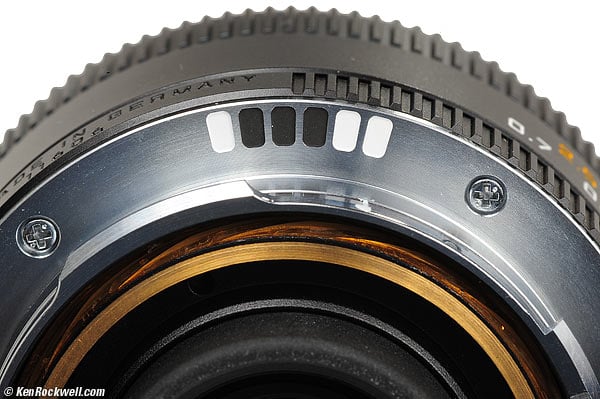
Six-dot code.
What LEICA tries to market as "six-bit encoding" is simply six white or black dots ground into the lens mount.
LEICA says "six-bit coding" to make it sound like some sort of advanced digital image processing algorithm. It's not: it's just a few colored dots.
The M8 and M9 reads these with LEDs to figure out what lens it is, so the can put the focal length data in the M8's EXIF. These is no aperture communication, so I doubt the M8 can do much of a decent job of encoding the set aperture value.
A bit is a simple yes-no or 1-0 value, in this case, marked with either white or black in six places. Big deal.
LEICA Product Numbers
Lens, complete boxed system with accessories: 11 606.Hood: 12 526.
Hood Cap: 14 043.
Rear Cap: 14 269.
Shipping since
October 2006.
Price, USA
October 2017
$2,297 for the newer version with metal hood;
About $1,500 used for this version if you know How to Win at eBay.
October 2011
$2,000.
January 2009
$1,800, and with $300 mail-in rebate it was effectively $1,500.
February 2007
$1,495.
Performance top
My tests are on Fuji Velvia 50 on an M7, and on the LEICA M9.
When I got my test slides back, all I could utter was "those crazy Germans." This lens doesn't know how to flare, doesn't know how to distort and doesn't know how to be unsharp.
All the LEICA 28mm f/2.8 ASPH knows is how etch your film with perfection.
Sharpness
For sharpness, you can shoot it wide open and get results much better than any SLR or rangefinder lens I've ever shot on Nikon.
Unlike the Nikon lenses, this LEICA lens doesn't know how to go soft in the corners, even at large apertures.
If you're looking closely, like under 40x magnification of a Nikon Alphapot laboratory microscope, the farthest corners get just a hair less sharp at f/2.8 than they are at every other aperture, but they are still excellent.
At f/2.8 in the far corners of the full 35mm film frame, way beyond the edges of the M8.2's half-frame sensor, sharpness is merely excellent.
At every other aperture, or anyplace else in the full-frame other than the farthest corners at f/2.8, the sharpness is just crazy.
I'm amused at how LEICA tries to make people who buy this $1,800 lens feel unworthy, calling it merely an "introduction" to the LEICA system. LEICA is trying to taunt you into buying the 28mm f/2 ASPH, but if you buy one for $4,000, you'll have some of your viewfinder obscured because it's bigger, you'll get three times the distortion of straight lines, and you'll have to use larger 46mm filters.
Flare and Ghosts
I can't see any, even with the sun in my image. Be careful not to burn your shutter curtains trying this foolishness.
Sunstars
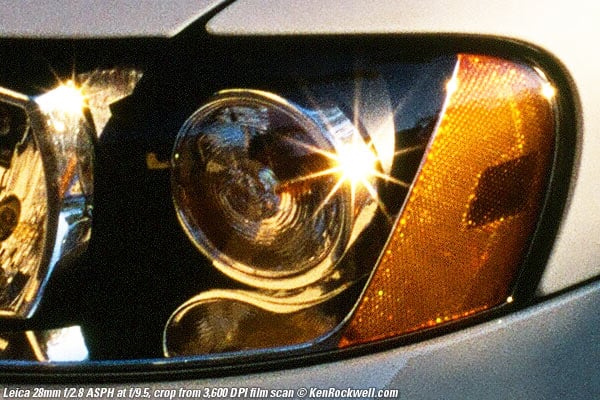
Sunstar at f/9.5, crop from 4 x 3 foot (130 x 85cm) print.
The 10-bladed diaphragm begets sharp 10-ponted sunstars.
Distortion
Monterey Aquarium, 28 August 2011 (LEICA M9). Straight enough? bigger.
There is no visible distortion of straight lines.
For critical use when shot at infinity, use a value of +0.5 in Photoshop's Lens Distortion Tool to correct the tiny amount of residual barrel distortion in scans from film.
Shot at 6 feet or 3 feet (2 meters or 1 meter), there is no distortion, visible or otherwise.
Color Balance
I wasn't specifically looking for it, but when compared to the Contax G 28mm, it seems much warmer, maybe half an 81A or an A1. I'll have to investigate further.
Coma
There is no coma, which is when bright points of light in the corners turn into blobs. Coma is common in wide and in fast lenses.
This lack of coma is superb, and far better than any SLR lens I've ever used.
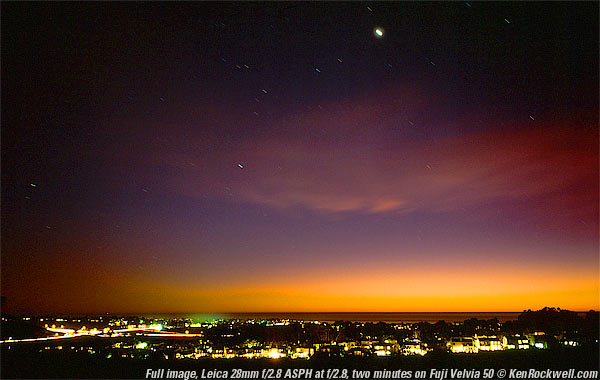
LEICA 28mm f/2.8 Aspherical wide-open at two minutes on Fuji Velvia 50.
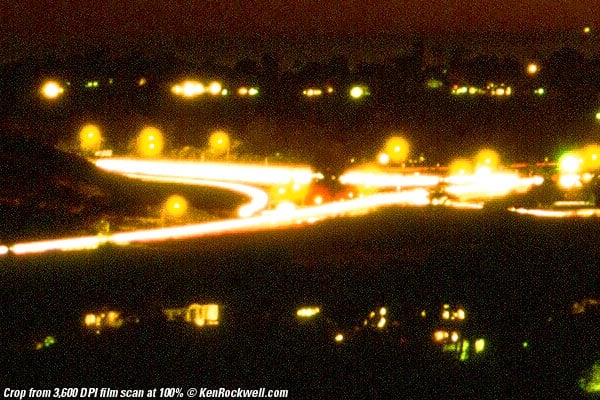
Crop from lower left corner.
I see no coma, and this crop is the same as a crop from a huge 48 x 32" (120 x 80cm) print.
Falloff (darkened corners)
I never noticed any in real shooting, even at f/2.8.
If I did look for it, it has some at f/2.8, much less at f/4, and it's all gone by f/5.6 ~ 8.
Remember: darker corners are good for keeping your viewer's eyes from wandering out of the photo and keeping their attention in your photo where it belongs.
Diaphragm Linearity
My M7 agreed exactly as I tried every half-stop.
Lesser lenses often become inaccurate at smaller apertures.
This isn't important on cameras which meter through-the-lens at taking aperture, like most modern LEICAs, but will lead to inaccurate exposures if you're using an external meter.
As far as I can measure, this lens is perfect.
The LEICA 28mm f/2.8 ASPH is made as well as anything popular today, but not quite as nice as Nikon's AI-s manual-focus lenses.
Caps
Medium-soft plastic.
Hood
Plastic with metal catches.
Barrel
Black anodized aluminum.
Focus Ring
Black anodized aluminum.
Focus Tab
Plastic.
Aperture Ring
Black anodized aluminum.
Finish
Black anodized aluminum.
(Nikon AI-s lenses add a layer of enamel over the anodization.)
Focus Helicoids
Aluminum and brass.
Other Internals
Metal.
Mount
Dull chromed brass.
Mounting Index Dot
Red plastic.
Markings
Engraved and filled with paint.
Quality
MADE IN GERMANY.
Viewfinder Blockage
LEICA 28mm f/2.8 ASPH on an M7, top view. enlarge.
The lower right of the viewfinders of my M4-P and M7 just barely see the tip of the lens. With a naked lens, there's no occlusion.
If you add a filter, there's a tiny bit of blockage, but nothing I'd worry about.
If you use the included hood, there is some blockage of the lower right.
If you use a 39mm -> 58mm step-up ring to use larger and stacked filters, you'll lose a good chunk of the corner of your finder, about equivalent to the corner of where a frame for a 65mm lens would go.
LEICA has this problem because today's M7 still puts the lens and viewfinder in the same place as 1954's original M3. The M3 came out before 28mm lenses were popular and before any camera's viewfinder could handle what were the "ultrawide" lenses of the 1950s. In the early 1950s, crazy people who used such wide lenses had to use external shoe-mounted finders.
Ergonomics
LEICA 28mm f/2.8 ASPH on an M7, side view. enlarge.
You focus this tiny thing with a finger lever. There isn't much of a focus ring.
The aperture ring is perfect. It's easy to adjust with a fingertip.
The 28mm f/2.8 is so small that there's no big place to grab the barrel for mounting and unmounting. Your best bet is the tiny sliver of ring at the very base of the lens, the part with the red dot.
The f/stop index is recessed inside the grooves which serve to align the hood, making it harder to see the f/stop index if you're not using the hood.
If you use the hood, there are new indices on the tabs of the hood which fill the grooves, making it much easier to see.
LEICA 28/2.8 M Aspherical. enlarge.
Recommendations top
I use one of these because it's tiny and excellent.
In the lab, the LEICA SUMMICRON-M 28mm f/2 ASPH can be slightly sharper, but it's also bigger, takes a larger 46mm filter, blocks my viewfinder, and has slightly more distortion.
Lenses are always a good investment; there's every reason to believe that this lens will be as useful 55 years from today as it is on my 55-year-old LEICA M3.
I also compared this LEICA 28mm f/2.8 ASPH to the extraordinary Zeiss-for-Contax-G 28mm f/2.8. I found them equally excellent, and each far better than anything I've ever used on an SLR.
As rangefinder lenses, these lenses are designed without the optical restrictions imposed by having to avoid the reflex mirror of SLR cameras.
The 1950's Nikon 2.8cm (28mm) f/3.5 lens for Nikon rangefinder cameras is poor. It's just nowhere near as sharp as either the Zeiss-for-Contax or this LEICA 28mm.
28mm is a much more practical lens than 24mm on the LEICA. It makes no difference on SLRs, but on most LEICAs, you probably have a 28mm viewfinder built into your camera. With a 24mm lens, you have to use a ridiculous shoe-mounted external finder. An external finder is more hassle than you can imagine.
An external finder requires you to peer through one hole to meter and focus, and another to compose. God help you if you use the wrong hole. Not only is using an external finder a pain and more junk to carry, forget using flash because it just took over your hot shoe.
24mm doesn't see enough differently for me to warrant the use of an external finder. If I want to mess with a finder, I'll shoot a 21mm or wider lens.
Therefore, 28mm is the widest easy-to-use lens für LEICA. If I want use an external finder, I'll use one for a 21mm lens.
Don't cheap-out with a Voigtländer lens for your LEICA. See also Cosina, Voigtländer and other lenses for LEICA.
Use on the LEICA M3
There may be a tiny bit of interference between the lens' red plastic mounting index ball and the small ring surrounding the LEICA M3's lens release button.
If this happens, a little bit of force will work it out, and it then should mount and unmount well as the ball will now conform to your M3.
Deployment
I use a 39mm 81A B+W brand filter for slide film.
I'd use any 39mm B+W brand yellow filter for B&W film outdoors, or a 39mm LEICA brand 13 131 UV filter indoors.
I'd use a 39mm LEICA brand 13 131 UV filter for color print film, but why would anyone shoot color print film in a LEICA?
For the LEICA M9 and LEICA M9-P, use a 39mm LEICA brand 13 131 UV filter or go commando.
For the wretchedly obsolete LEICA M8, use a LEICA brand 39mm UV/IR filter 13 410 (or a B+W brand 39mm UV/IR filter) to correct for a design flaw in the M8's sensor system design.
More Information
Popular Photography reviewed the LEICA 28mm f/2.8 ASPH in their February 2007 issue.
© Ken Rockwell. All rights reserved. Tous droits réservés. Alle Rechte vorbehalten.
Help Me Help You
I support my growing family through this website, as crazy as it might seem.
The biggest help is when you use any of these links when you get anything. It costs you nothing, and is this site's, and thus my family's, biggest source of support. These places always have the best prices and service, which is why I've used them since before this website existed. I recommend them all personally.
If you find this page as helpful as a book you might have had to buy or a workshop you may have had to take, feel free to help me continue helping everyone.
If you've gotten your gear through one of my links or helped otherwise, you're family. It's great people like you who allow me to keep adding to this site full-time. Thanks!
If you haven't helped yet, please do, and consider helping me with a gift of $5.00.
As this page is copyrighted and formally registered, it is unlawful to make copies, especially in the form of printouts for personal use. If you wish to make a printout for personal use, you are granted one-time permission only if you PayPal me $5.00 per printout or part thereof. Thank you!
Thanks for reading!
Mr. & Mrs. Ken Rockwell, Ryan and Katie.

